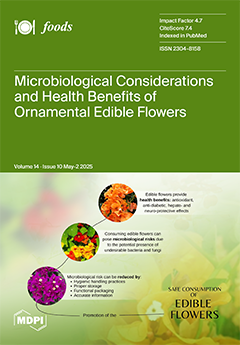Two-dimensional gas chromatography-time-of-flight mass spectrometry (GC × GC-TOF MS) was employed to analyze the volatile flavor compounds (VOCs) of
Tricholoma matsutake samples from six different geographical regions: CX (Chuxiong), DL (Dali), DQ (Diqing), JL (Yanji), SC (Xiaojin) and XZ (Linzhi). The result indicate
[...] Read more.
Two-dimensional gas chromatography-time-of-flight mass spectrometry (GC × GC-TOF MS) was employed to analyze the volatile flavor compounds (VOCs) of
Tricholoma matsutake samples from six different geographical regions: CX (Chuxiong), DL (Dali), DQ (Diqing), JL (Yanji), SC (Xiaojin) and XZ (Linzhi). The result indicate that a total of 2730 kinds of VOCs were identified from the fruiting bodies of six
T. matsutake samples. The primary types of volatile organic compounds identified were 349 alcohols, 92 aldehydes, 146 carboxylic_acids, 311 esters, 742 organoheterocyclic compounds, 630 hydrocarbons, 381 ketones, 51 organic acids, and 28 derivatives and organosulfur compounds. Furthermore, PCA and PLS-DA analysis from the GC×GC-ToF-MS showed that samples from different regions could be distinguished by their VOCs. Network analysis revealed that 33 aroma compounds were identified as markers for distinguishing the samples from the six regions. The sensory attributes sweet, fruity, green, waxy, and floral were found to be more significant to the flavor profile of
T. matsutake. 1-Nonanol, 2-Nonanone, Nonanoic acid, ethyl ester, 1-Undecanol, 2-Undecanone, Octanoic acid, ethyl ester, 2H-Pyran, and tetrahy-dro-4-methyl-2-(2-methyl-1-propenyl)- primarily contribute to the differences in the aroma characteristics among six
T. matsutake samples. The results also provide a theoretical and practical foundation for the flavor compounds of these precious edible fungi in different regions.
Full article






